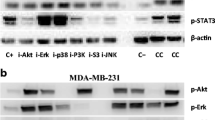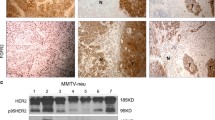Abstract
We present a mathematical model to study the effects of HER2 over-expression on cell proliferation in breast cancer. The model illustrates the proliferative behavior of cells as a function of HER2 and EGFR receptors numbers, and the growth factor EGF. This mathematical model comprises kinetic equations describing the cell surface binding of EGF growth factor to EGFR and HER2 receptors, coupled to a model for the dependence of cell proliferation rate on growth factor receptors binding. The simulation results from this model predict: (1) a growth advantage associated with excess HER2 receptors; (2) that HER2-over-expression is an insufficient parameter to predict the proliferation response of cancer cells to epidermal growth factors; and (3) the EGFR receptor expression level in HER2-over-expressing cells plays a key role in mediating the proliferation response to receptor-ligand signaling. This mathematical model also elucidates the interaction and roles of other model parameters in determining cell proliferation rate of HER2-over-expressing cells.
Similar content being viewed by others
References
Alroy, I., Yarden, Y., 1997. The ErbB signaling network in embryogenesis and oncogenesis: signal diversification through combinatorial ligand-receptor interactions. FEBS Lett. 410, 83–86.
Brennan, P.J., et al., 2000. HER2/neu: mechanisms of dimerization/oligomerization. Oncogene 19, 6093–6101.
Carraway, K.L. III, Cantley, L.C., 1994. A Neu acquaintance for ErbB3 and ErbB4: a role for receptor heterodimerization in growth signaling. Cell 78, 5–8.
Clark, G.M., McGuire, W.L., 1991. Follow-up study of HER-2/neu amplification in primary breast cancer. Cancer Res. 51, 944–948.
Difiore, P.P., Pierce, J.H., Kraus, M.H., Segatto, O., King, C.R., Aaronson, S.A., 1987. ErbB-2 is a potent oncogene when overexpressed in NIH 3T3 cells. Science 237, 178–182.
Graus-Porta, D., et al., 1997. ErbB-2, the preferred heterodimerization partner of all ErbB receptors, is a mediator of lateral signaling. EMBO J. 16, 1647–55.
Harris, R.A., Eichholtz, T.J., Hiles, I.D., Page, M.J., O’Hare, M.J., 1999. New model of ErbB-2 oeverexpression in human mammary luminal epithelial cells. Int. J. Cancer 80, 477–484.
Hart, D., Shochat, E., Agur, Z., 1998. The growth law of primary breast cancer tumors as inferred from mammography screening trials. Br. J. Cancer 78(3), 382–387.
Hendriks, B., Opresko, L.K., Wiley, H.S., Lauffenburger, D.A., 2003a. Quantitative analysis of HER2-mediated effects on HER2 and EGFR endocytosis: distribution of homo- and hetero-dimers depends on relative HER2 levels. J. Biol. Chem. 278, 23343–23351.
Hendriks, B., Wiley, H.S., Lauffenburger, D.A., 2003b. HER2-mediated effects on EGFR endosomal sorting: analysis of biophyical mechanisms. Biophys. J. 85, 2732–2745.
Hendriks, B.S., Orr, G., Wells, A., Wiley, H.S., Lauffenburger, D.A., 2005. Parsing ERK activation reveals quantitatively equivalent contributions from EGFR and HER2 in human mammary epithelial cells. J. Biol. Chem. 280, 6157–6169.
Hynes, N.E., Lane, H.A., 2005. ERBB receptors and cancer: the complexity of targeted inhibitors. Nat. Rev. Cancer 5, 341–354.
Hynes, N.E., Horsch, K., Olayioye, M.A., Badache, A., 2001. The ErbB receptor tyrosine family as signal integrators. Endocr. Relat. Cancer 8, 151–159.
Karunagaran, D., Tzahar, E., Berrli, R.R., Chen, X., Graus-Porta, D., 1996. Common auxiliary subunit of NDF and EGF receptors: implications for breast cancer. EMBO J. 15, 254–264.
Keshet, L.E., 1988. Mathematical Models in Biology, 1st edn. McGraw–Hill, New York.
Knauer, D., Wiley, H., Cunningham, D., 1984. Relationship between epidermal growth factor receptor occupancy and mitogenic response. Quantitative analysis using a steady state model system. J. Biol. Chem. 259, 5623–5631.
Kurebayashi, J., 2001. Biological and clinical significance of HER2 overexpression in breast cancer. Breast Cancer 8, 45–51.
Lauffenburger, D.A., Linderman, J., 1996. Receptors: Models for Binding, Trafficking, and Signaling. Oxford University Press, Oxford.
Maguire, H.C. Jr., Greene, M.I., 1989. The neu (c-erbB-2) oncogene. Semin. Oncol. 16, 148–155.
Menard, S., Tagliabue, E., Campligio, M., Pupa, S., 2000. Role of HER2 gene overexpression in breast carcinoma. J. Cell. Phys. 182, 150–162.
Monod, J., 1949. The growth of bacterial cultures. Ann. Rev. Microbiol. 3, 371–394.
Riese, D.J., Stern, D.F., 1998. Specificity within the EGF family/ErbB receptor family signaling network. Bioessays 20, 41–48.
Robert, N., Leyland-Jones, B., Asmar, L., Belt, R., Ilegbodu, D., Loesch, D., Raju, R., Valentine, E., Sayre, R., Albain, K., Cobleigh, M., McCullough, C., Fuchs, L., Slamon, D., 2002. Phase III comparative study of trastuzumab and paclitaxel with and without carboplatin in patients with HER-2/neu positive advanced breast cancer. Program and Abstracts of the 25th Annual San Antonio Breast Cancer Symposium, December 11–14, 2002, San Antonio, Texas. Abstract 35.
Salomon, D.S., Brandt, R., Ciardiello, F., et al., 1995. Epidermal growth factor-related peptides and their receptors in human malignancies. Crit. Rev. Oncol. Hematol. 19, 183–232.
Slamon, D.J., Clark, G.M., Wong, S.G., et al., 1987. Human breast cancer: Correlation of relapse and survival with amplification of the HER-2/neu oncogene. Science 235, 177–182.
Slamon, D., Godolphin, W., Jones, L., et al., 1989. Studies of the HER-2/neu proto-oncogene in human breast and ovarian cancer. Science 244, 707–712.
Stampfer, M.R., Bartley, J.C., 1985. Induction of transformation and continuous cell lines from normal human mammary epithelial cells after exposure to benzo[a]pyrene. Proc. Natl. Acad. Sci. USA 82, 2394–2398.
Starbuck, C., Wiley, S.H., Lauffenburger, D.A., 1990. Epidermal growth factor binding and trafficking dynamics in fibroblasts: relationship to cell proliferation. Chem. Eng. Sci. 45, 2367–2373.
Timms, J.F., White, S.L., O’Hare, M.J., Waterfield, M.D., 2002. Effects of ErbB-2 overexpression on mitogenic signalling and cell cycle progression in human breast luminal epithelial cells. Oncogene 21(43), 6573–86.
Tzahar, E., et al., 1996. A hierarchical network of interreceptor interactions determines signal transduction by Neu differentiation factor/neuregulin and epidermal growth factor. Mol. Cell. Biol. 16, 5276–87.
Ullrich, A., Schlessinger, J., 1990. Signal transduction by receptors with tyrosine kinase activity. Cell 61, 203–12.
Wiley, H.S., Cunningham, D.D., 1981. A steady-state model for analyzing the cellular-binding, internalization, and degradation of polypeptide ligands. Cell 25(2), 433–440.
Wiley, H.S., Shvartsman, S.Y., Lauffenburger, D.A., 2003. Computational modeling of the EGF-receptor system: a paradigm for systems biology. Trends Cell. Biol. 13, 43–50.
Wilson, A.C., Cajulis, E.E., Green, L.J., Olsen, M.T., Chung, A.Y., Damore, A.M., Dering, J., Calzone, J.F., Slamon, J.D., 2005. HER-2 overexpression differentially alters transforming growth factor-β responses in luminal versus mesenchymal human breast cancer cells. Breast Cancer Res. 7, 1058–1079.
Yarden, Y., Sliwkowski, M.X., 2001. Untangling the ErbB signalling network. Nat. Rev. Mol. Cell. Biol. 2, 127–137.
Author information
Authors and Affiliations
Corresponding author
Rights and permissions
About this article
Cite this article
Eladdadi, A., Isaacson, D. A Mathematical Model for the Effects of HER2 Overexpression on Cell Proliferation in Breast Cancer. Bull. Math. Biol. 70, 1707–1729 (2008). https://doi.org/10.1007/s11538-008-9315-4
Received:
Accepted:
Published:
Issue Date:
DOI: https://doi.org/10.1007/s11538-008-9315-4




